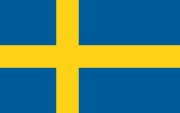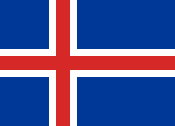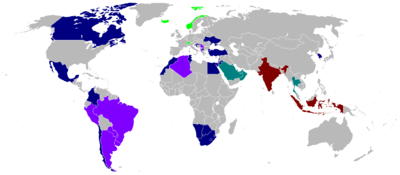European Free Trade Association
| European Free Trade Association (EFTA) Association européenne de libre-échange (AELE) (French)
Europäische Freihandelsassoziation (German) Fríverslunarsamtök Evrópu (Icelandic) Det europeiske frihandelsforbund (Norwegian) |
||||
|---|---|---|---|---|
|
||||
 |
||||
| Secretariat | Geneva, Switzerland | |||
| Official languages | German, French, Norwegian, and Icelandic | |||
| Type | Trade bloc | |||
| Member states | ||||
| Leaders | ||||
| - | Secretary General | Kåre Bryn | ||
| Establishment | 3 May 1960 | |||
| - | EFTA Convention | 4 January 1960 | ||
| Area | ||||
| - | Total | 529,600 km2 204,518 sq mi |
||
| Population | ||||
| - | 2007 estimate | 12,660,623 | ||
| - | Density | 100.6/km2 59.82/sq mi |
||
| GDP (PPP) | 2007 (IMF) estimate | |||
| - | Total | $567.5 billion | ||
| - | Per capita | $44,828 | ||
| GDP (nominal) | 2007 (IMF) estimate | |||
| - | Total | $743.3 billion | ||
| - | Per capita | $58,714 | ||
| Currency | Icelandic króna, Norwegian krone, Swiss franc (ISK, NOK, CHF) |
|||
| Time zone | WET / CET (UTC+0 / +1) | |||
| - | Summer (DST) | WEST / CEST (UTC+1 / +2) | ||
The European Free Trade Association (EFTA) is a free trade organisation between four European countries that operates parallel to, and is linked to, the European Union (EU).
EFTA was established on 3 May 1960 as a trade bloc-alternative for European states who were either unable to, or chose not to, join the then-European Economic Community (EEC) which has now become the European Union (EU). The Stockholm Convention, establishing EFTA, was signed on 4 January 1960 in Stockholm by seven countries.
Today, only Iceland, Norway, Switzerland, and Liechtenstein remain members of EFTA (of which Norway and Switzerland are the only remaining founding members). The Stockholm Convention was subsequently replaced by the Vaduz Convention. This Convention provides for the liberalisation of trade among the member states.
Three of the EFTA countries are part of the European Union Internal Market through the Agreement on a European Economic Area (EEA), which took effect in 1994; the fourth, Switzerland, opted to conclude bilateral agreements with the EU. In addition, the EFTA states have jointly concluded free trade agreements with a number of other countries.
In 1999 Switzerland concluded a set of bilateral agreements with the European Union covering a wide range of areas, including movement of persons, transport and technical barriers to trade. This development prompted the EFTA States to modernise their Convention to ensure that it will continue to provide a successful framework for the expansion and liberalization of trade among them and with the rest of the world.
Contents |
Political history
British reaction to the creation of the EEC was mixed and complex. Consequently, in 1960 (after the creation of EFTA), France vetoed British membership fearing that the Anglo-Saxons planned a federal super-state modeled on the USA. Britain was also preoccupied with the Commonwealth, which was in a critical period. The UK brought together several countries (including some bordering the EEC) and decided to form the European Free Trade Association in about 1959, soon after the establishment of the 6-nation EEC. (France, Germany, Italy, Belgium, Luxembourg, and the Netherlands. These last three are also known as the Benelux Union.)
On January 4, 1960 the Treaty on European Free Trade Association was initialed in the Golden Hall of the Prince's Palace of Stockholm. This established the progressive elimination of customs duties on industrial products, but did not affect agricultural products or maritime trade.
The main difference between the early EEC and the EFTA was the absence of a common external customs tariff, and therefore each EFTA member was free to establish individual customs duties against trade with non EFTA countries.
Despite this modest initiative, the financial results were excellent, as it stimulated an increase of foreign trade volume among its members from 3 522 to 8 172 million US dollars between 1959 and 1967. This was however rather less than the increase enjoyed by countries inside the EEC.
After the accession of Denmark and the UK to the EEC, EFTA began to falter. For this reason most countries eased or eliminated their trade tariffs in preparation to join the EEC, but experienced declining revenue which reduced the importance of EFTA. Currently there are only 4 members remaining: Switzerland, Norway and Liechtenstein and Iceland. Iceland applied for EU membership in 2009 following the 2008–2009 Icelandic financial crisis.
Membership history

The founding members of EFTA were Austria, Denmark, Norway, Portugal, Sweden, Switzerland and the United Kingdom. During the 1960s these countries were often referred to as the Outer Seven, as opposed to the Inner Six of the then-European Economic Community (EEC).[1]
Finland became an associate member in 1961 (becoming a full member in 1986) and Iceland joined in 1970. The United Kingdom and Denmark joined the EEC in 1973 (together with Ireland), and hence ceased to be EFTA members. Portugal also left the EFTA for the European Community in 1986. Liechtenstein joined in 1991 (previously its interests in EFTA had been represented by Switzerland). Finally, Austria, Sweden and Finland joined the EEC (now the EU) in 1995 and thus ceased to be EFTA members.
Current members
| Flag | State | Official name | Accession | Population | Area (km²) | Capital | GDP in millions (PPP) | GDP per capita (PPP) |
|---|---|---|---|---|---|---|---|---|
| Iceland | Iceland | 1 January 1970 | 320,000 | 103,000 | Reykjavík | 12,144 | 39,168 | |
| Liechtenstein | Principality of Liechtenstein | 1 January 1991 | 34,247 | 160.4 | Vaduz | 4,160 | 118,000 | |
| Norway | Kingdom of Norway | 3 May 1960 | 4,721,600 | 385,155 | Oslo | 247,416 | 53,152 | |
| Switzerland | Swiss Confederation (Confoederatio Helvetica ) | 3 May 1960 | 7,591,400 | 41,285 | Bern | 300,186 | 41,265 |
General Secretaries
General Secretaries of EFTA:
- 1960-1965:
 Frank E. Figgures
Frank E. Figgures - 1965-1972:
 Sir John Coulson
Sir John Coulson - 1972-1975:
 Bengt Rabaeus
Bengt Rabaeus - 1976-1981:
 Charles Müller
Charles Müller - 1981-1988:
 Per Kleppe
Per Kleppe - 1988-1994:
 Georg Reisch
Georg Reisch - 1994-2000:
 Kjartan Jóhannsson
Kjartan Jóhannsson - 2000-2006:
 William Rossier
William Rossier - 2006–present:
 Kåre Bryn
Kåre Bryn
Institutions
EFTA is governed by the EFTA Council and serviced by the EFTA Secretariat. In addition, in connection with the EEA Agreement of 1992, two other EFTA organisations were established, the EFTA Surveillance Authority and the EFTA Court.
The EFTA Surveillance Authority and the EFTA Court regulate the activities of the EFTA members in respect of their obligations in the European Economic Area (EEA). Since Switzerland is not an EEA member, it does not participate in these institutions.
The EFTA Surveillance Authority performs the European Commission's role as "guardian of the treaties" for the EFTA countries, while the EFTA Court performs the European Court of Justice's role for those countries.
The original plan for the EEA lacked the EFTA Court or the EFTA Surveillance Authority, and instead had the European Court of Justice and the European Commission were to exercise those roles. However, during the negotiations for the EEA agreement, the European Court of Justice informed the Council of the European Union by way of letter that they considered that giving the EU institutions powers with respect to non-EU member states would be a violation of the treaties, and therefore the current arrangement was developed instead.
The EEA and Norway Grants are administered by the Financial Mechanism Office, which is affiliated to the EFTA Secretariat in Brussels.
Locations
The EFTA Secretariat is headquartered in Geneva, Switzerland. The EFTA Surveillance Authority has its headquarters in Brussels, Belgium (the same location as the headquarters of the European Commission), while the EFTA Court has its headquarters in Luxembourg (the same location as the headquarters of the European Court of Justice).
Portugal Fund
The Portugal Fund was established in 1975 when Portugal was still a member of EFTA, to provide funding for the development and reconstruction of Portugal after the Carnation Revolution. When Portugal left EFTA in 1985 to join the EEC, the remaining EFTA members decided to nonetheless continue the Portugal Fund, so Portugal would continue to benefit from it. The Fund originally took the form of a low-interest loan from the EFTA member states to Portugal, to the value of 100 million US dollars. Repayment was originally to commence in 1988, but EFTA then decided to postpone the start of repayments until 1998. The Portugal Fund has now been dissolved by the Member States.
International conventions
EFTA also originated the Hallmarking Convention and the Pharmaceutical Inspection Convention, both of which are open to non-EFTA states.
Relationship to the European Economic Area
The EFTA members, except for Switzerland, are also members of the European Economic Area (EEA).


International relationships
EFTA has several free trade agreements with non-EU countries as well as declarations on cooperation and joint workgroups to improve trade. Currently, the EFTA States have established preferential trade relations with 20 States and Territories, in addition to the 27 Member States of the European Union.[2]

Free Trade Agreement
- Canada
- Chile
- Croatia
- Egypt
- Israel (Switzerland exempt)
- Jordan
- South Korea
- Lebanon
- Macedonia
- Mexico
- Morocco (Excluded Western Sahara[3])
- Palestinian National Authority
- Singapore
- Southern African Customs Union (Botswana, Lesotho, Namibia, Swaziland, South Africa)
- Tunisia
- Turkey
Signed agreement 2008, not yet ratified
Signed agreement 2009, not yet ratified
Signed agreement 2010, not yet ratified
Finalised negotiations 2008
Currently negotiating agreements
Declarations on Cooperation
Joint workgroups
Future

and EFTA countries (green)
The Norwegian electorate has rejected treaties of accession to the EU in two referenda. At the time of the first referendum (1972) their neighbour Denmark joined. The second time (1994) two other Nordic neighbours, Sweden and Finland, joined the EU. The last two governments of Norway have been unable and unwilling to advance the question, as they have both been coalition governments consisting of proponents and opponents.
Since Switzerland rejected the EEA in 1992, referenda on EU membership have been initiated, the last time in 2001. These were rejected by clear majorities.
Iceland, on the other hand, may join the EU in the near future, following the global financial crisis of 2008, which has particularly affected the local economy. On 16 July 2009, the government formally applied for EU membership.[5]
In mid-2005, representatives of the Faroe Islands hinted at the possibility of their territory joining EFTA.[6] However, the chances of the Faroes' bid for membership are uncertain because, according to Article 56 of the EFTA Convention, only states may become members of the Association.[7] The Faroes already have an extensive bilateral free trade agreement with Iceland, known as the Hoyvík Agreement.
EFTA and the European Union
This table summarises the various components of EU laws applied in the EFTA countries and their sovereign territories. Some territories of EU member states also have a special status in regard to EU laws applied as is the case with some European microstates.
| EFTA member states and sovereign territories |
Application of EU law |
Enforceable in local courts? | EURATOM? | EU citizenship? |
EU elections? |
Schengen area? | EU VAT area? | EU customs territory? | EU single market? | Eurozone? | |
|---|---|---|---|---|---|---|---|---|---|---|---|
| Partial | No | No | No | No | Yes | No | No | Yes[8] | No, ISK | ||
| Partial | Unclear | No | No | No | Set to implement later | No | No | Yes[8] | No, CHF | ||
| Partial | Unclear | No | No | No | Yes | No | No | Yes[8] | No, NOK | ||
| Partial | Unclear | No | No | No | No[9] | No[10] | No | No[8][11] | No, NOK | ||
| Partial | Unclear | No | No | No | Yes[12] | No | No | Yes[8][13] | No, NOK | ||
| Partial | Unclear | No | No | No | Yes[12] | No | No | Yes[8][13] | No, NOK | ||
| Partial | Unclear | No | No | No | Yes[12] | No | No | Yes[8][13] | No, NOK | ||
| Partial | Unclear | No | No | No | Yes | No | No | Yes[14] | No, CHF | ||
| Member states and sovereign territories |
Application of EU law |
Enforceable in local courts? | EURATOM? | EU citizenship? |
EU elections? |
Schengen area? | EU VAT area? | EU customs territory? | EU single market? | Eurozone? | |
See also
- Central European Free Trade Agreement (CEFTA)
- Enlargement of the European Union
- Euro-Mediterranean free trade area (EU-MEFTA)
- Free trade areas in Europe
- European Union free trade agreements
- European Union Association Agreement, which covers many more countries
- Trade bloc
- Schengen Agreement
References
- ↑ "Finland: Now, the Seven and a Half". TIME. 1961-04-07. http://www.time.com/time/magazine/article/0,9171,874317,00.htm. Retrieved 2009-07-18.
- ↑ Official EFTA site
- ↑ "Western Sahara excluded from EFTA-Morocco free trade agreement". SPS. 12-05-2010. http://www.spsrasd.info/en/detail.php?id=11569. Retrieved 13-05-2010.
- ↑ Ukraine signs agreement on free trade zone with EFTA, Kyiv Post (June 24, 2010)
- ↑ "Iceland moves towards joining EU". BBC News. 2009-07-16. http://news.bbc.co.uk/2/hi/europe/8153139.stm. Retrieved 2009-07-18.
- ↑ Spongenberg, Helena (2007-10-08). "Faroe Islands seek closer EU relations". EUobserver. http://euobserver.com/9/24907. Retrieved 2009-07-18.
- ↑ "Convention Establishing the European Free Trade Association" (PDF). 2001-06-21. http://www.efta.int/content/legal-texts/efta-convention/eftaconvention-texts/convention-2001. Retrieved 2009-07-18.
- ↑ 8.0 8.1 8.2 8.3 8.4 8.5 8.6 European Economic Area
- ↑ Norway and Iceland Schengen association agreement Article 14
- ↑ Because of the Svalbard treaty it is even outside of the Norway taxation area.
- ↑ Agreement on the European Economic Area - Protocol 40 on Svalbard and Declaration for activation of Protocol40 exclusion.
- ↑ 12.0 12.1 12.2 Not explicitely mentioned in the treaty as excluded, thus considering it included.
- ↑ 13.0 13.1 13.2 Agreement on the European Economic Area, Article 126 Not explicitely mentioned in the treaty as excluded, thus considering it included.
- ↑ Through multiple sectoral agreements
|
|||||
|
||||||||||||||||||||||||||||||||
